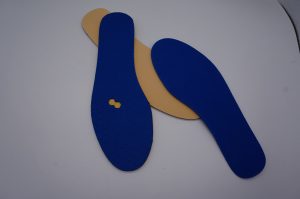Diabetic insoles are an important auxiliary tool for daily foot care for diabetic patients, and the selection of their materials is crucial. Different materials have differences in production process, finished product effect and user experience. This article will conduct an in-depth analysis and comparison of several common diabetic insole materials to explore which material is more suitable for making diabetic insoles.

1. Overview of common diabetic insole materials
Common diabetic insole materials currently on the market include memory foam, gel, EVA (ethylene-vinyl acetate copolymer), and polyurethane. These materials have their own characteristics and are suitable for diabetic patients with different needs.
2. Material analysis and comparison
Memory foam material
Manufacturing process: Memory foam insoles use a special manufacturing process to make the material have slow rebound properties and can adapt according to the shape and pressure distribution of the foot.
Finished product effect: Memory foam insoles can provide personalized support and fit, effectively relieving foot pain and pressure points. At the same time, its slow rebound properties help disperse the impact force during walking and reduce foot fatigue.
User experience: Most patients report that memory foam insoles are more comfortable, but they may change shape after long-term use and need to be replaced regularly.
Gel material
Production process: The gel insole is made of polymer gel material, which has excellent elasticity and shock-absorbing properties through a specific process.
Finished product effect: The gel insole can effectively absorb the impact of walking and reduce the vibration of the foot. At the same time, its excellent elasticity can maintain foot comfort and reduce pain.
User experience: Gel insoles usually have a cool touch and are suitable for summer use. However, some patients report that gel insoles may deform or harden after long-term use.
EVA material
Production process: EVA insoles are made of ethylene-vinyl acetate copolymer material through mold forming and heat treatment processes.
Finished product effect: EVA insoles have good elasticity and wear resistance, and can provide stable support and cushioning effects. Its lightweight nature also makes it ideal for long walks and long periods of standing.
User experience: EVA insoles are generally durable and easy to clean, and are loved by many patients. However, some patients with sensitive skin may have allergic reactions to EVA materials.
Polyurethane material
Production process: Polyurethane insoles are made through injection molding or foaming processes and have excellent elasticity and compression resistance.
Finished product effect: Polyurethane insoles can provide uniform support and cushioning, effectively reducing foot pain and discomfort. At the same time, its excellent compression resistance enables it to maintain its shape and performance for a long time.
User experience: Polyurethane insoles usually have high comfort and durability, but the price is relatively high.
3. Comprehensive analysis
To sum up, diabetic insoles made of various materials are different in production process, finished product effect and user experience. Memory foam and gel materials focus more on providing personalized support and comfort, but may have problems with shape changes or hardening; EVA and polyurethane materials focus more on elasticity and durability, which can meet the needs of long-term use.
Considering the special needs of diabetic patients, such as foot neuropathy, poor blood circulation, etc., it is recommended to choose materials with excellent support, cushioning and durability. Therefore, EVA and polyurethane materials may be ideal choices. However, specific choices need to be carefully considered based on the patient’s individual circumstances and needs.
Finally, no matter what kind of diabetic insoles are chosen, patients should pay attention to regular replacement and cleaning to maintain their best use. At the same time, it is recommended to select and use diabetic insoles under the guidance of a professional doctor to ensure their safety and effectiveness.
